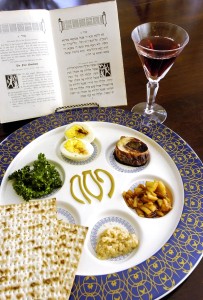 Last Friday, I attended a Seder. A couple days before, I joked with friends that I was going to celebrate the ritual dinner commemorating the Jews’ exodus from Egypt with real Jews.
Last Friday, I attended a Seder. A couple days before, I joked with friends that I was going to celebrate the ritual dinner commemorating the Jews’ exodus from Egypt with real Jews.
Those who know me know I was raised as a Lox’n Bagels Jew (I identified with the culture but didn’t speak Hebrew or was particularly observant of traditions). I had participated in Seders before but expected one held in an Orthodox home would be a very different kind of experience.
The Hebrew word “Seder” translates to “order.” I was struck by how much my initial reaction to the special meal and self-conducted service felt anything but orderly.
One of the traditions is the asking of The Four Questions. This, in itself, is a bit of a puzzle. There aren’t actually four different questions. One question is asked four times and is given four different answers.
The question is: “What makes this night different from all other nights?”
I couldn’t help but ask myself “What makes this Seder different from all other Seders?”
The traditional question has different answers that all refer to escaping from bondage and enjoying the life of free men. My question, “What makes this Seder different from all other Seders?” has different answers but all seem to come back to my notion of “order.”
After receiving the invitation, I asked my host when I should arrive. She told me that she lights candles at sunset and that her family starts the Seder about an hour afterwards.
I didn’t know what to make of this information. It was not like being told to come at 7:30. Was I supposed to come for Sabbath candle lighting or just for dinner? Apparently, it was for me to decide.
The leader of the service didn’t pass out copies of the same Haggadah to everyone as I was accustomed to, clearly marked with passages to be read by assigned individuals.
Haggadahs were distributed to anyone who wanted one, but there were maybe eight different versions. The idea was that you would pick out the translation that suited you and would follow the proceedings that way.
While there was a leader for the service, everyone was invited to contribute comments or questions, insights or observations.
As I looked around the room, everyone seemed to be doing their own thing.
The Seder leader read the text in Hebrew very quickly. My friend’s father, affectionately referred to as Zadie by everyone (grandfather) sang songs of the holiday, not concerned with whether anyone was listening. Guests shared thoughts about writings that pertained to particular Passover traditions.
One of the children sitting at the head table, presented his understanding of the 10 Plagues, which, according to the bible, was to demonstrate the power of God and persuade Pharaoh to let the Jews leave Egypt. He displayed representations of each plague, throwing fake lice and miniature frog-shaped toys across the room.
This Seder didn’t look like order to me.
Then I looked at the room from my heart. Everyone had so much love and respect for each other. Everyone followed their inner guidance. We all probably took a few moments to silently gather our thoughts and form prayers about how we wanted to spend the holiday the following year.
Maybe that is the truest meaning of why people celebrate the holiday. As free people, with faith in God and respect for others, we can create our own order -– one that is satisfying for ourselves and encouraging to those we love.
Seeing twenty-five people sitting around a dining table, each following their own impulses and giving everyone else space to follow theirs is no small thing.


My background is conservative Jew (more than bagels and Lox, but less than the folks you went to — and I’ve been to their sedars before), and actually what you’re describing is pretty normative for orthodox households and even more traditional conservative homes. I always know I’m in a more “less orthodox” home if I”m greeted by everyone reading from the same book rather than from a collection of books picked up over time, inherited, etc. with folks doing a lot of comparing and contrasting different annotations from their books, or different timings of when you do or do not drink that next glass. In my mind a “proper” sedar should be a bit like a graduate school class where everyone debates the meaning of line of text, and it’s as much about teaching Jewish thinking and history to the young ones in the room as it is about the food.
I am so glad to receive your comment. Thank you for writing. I like your analogy comparing a “proper” Seder to a grad school class. I certainly felt like I was taken to school. It’s challenging and exciting to be in an atmosphere where everything is questioned and yet someone it feels like everything is all right.